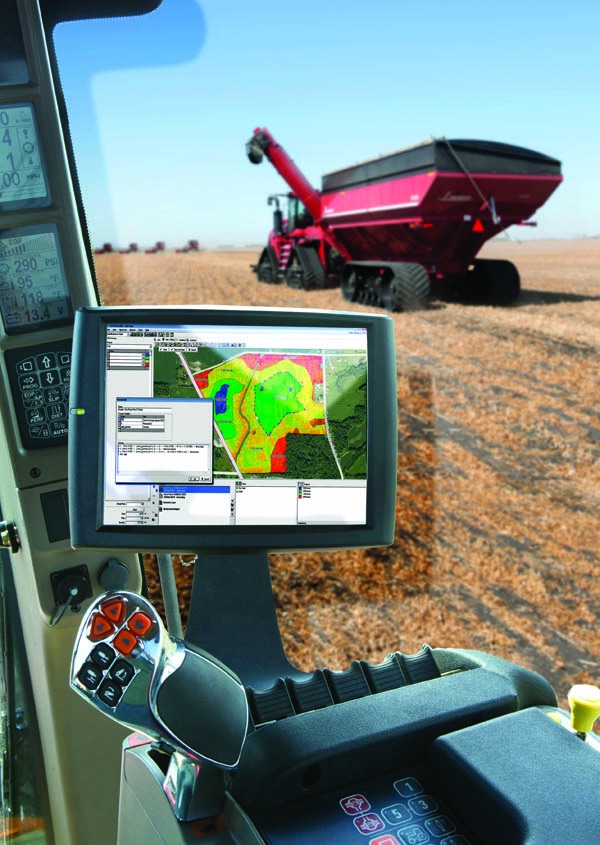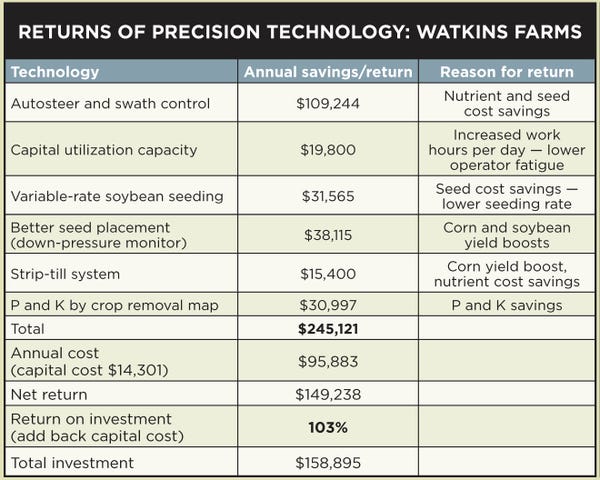
Measuring tech ROI on the farm
Precision technology requires both financial investment and the process of learning new farming practices. One northwest Ohio grower crunched the numbers to show that technology is truly paying off on his farm. Through input savings, efficient use of machinery and yield increases, precision practices really can help the bottom line.

Precision farming practices have been around for a long time. Yield monitors, grid soil sampling and variable-rate application of fertilizer were a few of the first types of precision agriculture products to be adopted beginning in the 1990s. But where are we now, and how are these technologies paying off?
That may be one of the biggest factors that has made growers weary of investing in expensive new technologies for the farm, ever since such products were first introduced. The most important question on their mind often focuses on just how those technologies will make them more efficient as growers, and ultimately, how they will make them more profitable.
Bruce Erickson, education distance and outreach director, Purdue University Department of Agronomy, points out that with some precision products, the return on the investment can be relatively easy to quantify.
“I have farmers who tell me they can pretty much pay off section control on a sprayer within a year [or between three and five years],” says Erickson. “They pretty much pay for themselves with a sizable farming operation.”

Photo: Mike Krivit
In Erickson’s presentation at the 2013 InfoAg conference in Springfield, Ill., he cited a number of precision products that save growers money primarily on input costs, including: GPS guidance and autosteer; sprayer nozzle and boom controls; and planter row controls and clutches. Growers see cost savings on fertilizer, seed, pesticide, fuel, labor and equipment when they adopt technologies like these. And they’re becoming more and more common in agriculture today as the return on investment is apparent and tangible.
But the next wave of precision farming may be harder to quantify, Erickson says.
“This whole next era is much, much more complicated, because the current era we’re in only depends on the field position we are in,” he explains. “This next era — we have to understand the variability in the field, and we have to characterize it, and we have to do something about it based on that, and that isn’t easy to do.”
Some of the technologies he cites as part of this next wave of a site-specific approach to precision farming include soil sampling with GPS; satellite and aerial imagery; telemetry; field mapping with GIS; greenness sensors; and variable-rate technology for fertilizer with multiple or single nutrients.
However, Erickson notes that a basic premise about all the information collected from using these systems does not have any value until it drives a decision.
“If you collect yield monitor information; if you do grid soil sampling; if you’re doing remote sensing imagery — there’s no economic payback to that until it drives a decision that provides more revenue for your farm,” he says. “And that additional revenue has to pay for the cost of collecting and analyzing all of this additional information. So that’s how the profit will have to be made. We’ll have to either be getting more yield in various parts of the field or saving on input costs. We’re going to have to be more efficient all over the field, or it’s not going to be worth doing.”
And while these types of precision products may be more difficult to quantify in terms of how they pay off for the grower, adoption of them at the dealership level, overall, is slowly but steadily rising, according to the Purdue/CropLife Precision Dealer Survey. The survey results also show that some of the common challenges in getting growers to adopt these “next-wave” precision products include demonstrating the value to the grower, finding employees to train growers on new products, and the fact that the equipment needed changes quickly.
Crunching the numbers: Watkins Farms
Brian Watkins is a grain and swine farmer in northwest Ohio who’s been adopting new precision ag practices for more than 20 years. The sixth-generation farmer speaks at agricultural conferences and educates audiences about the returns he’s seen from investing in new technology on his farm.

Brian Watkins, Watkins Farms
The table below shows Watkins’ figures from the 2013 growing season, which detail the returns he saw from all of the precision ag products he used, whether they were through input savings, yield increases or more efficient use of equipment.
“The single biggest driver of payback was the boom-control technology and planter row shutoff,” says Watkins in an interview with Farm Industry News. “That’s where the most dollars came from, and the critical thing there is the size of your fields and the shapes of your fields, because it greatly affects the percentages. When you have smaller fields and when you have odd-shaped angles, it’s a much bigger return than if you have big rectangular or square fields.”
And Watkins sees those paybacks because of his odd-shaped fields that are characterized by lots of waterways and streams. Sprayer shutoff really pays off when he deals with angled fields that total 7,000 acres.
While a grower in central Illinois may not have the same issues to deal with as Watkins does, he still recommends considering the potential benefits of new technology.
“Everybody should have a yield monitor on their combine. And if you have that and you don’t see much variation, then — hey — don’t worry about it. But the way to learn is to see how your yields vary, and if they vary, then there could be issues,” he says.
And knowing how to manage your data — taking the leap into that “next era” of precision ag — and understanding it is also crucial for growers, he says.
“The biggest thing is trying. It can be a challenge, but just trying to use the data, trying to learn.”

About the Author(s)
You May Also Like





